DOE, SURA Sign 5-year Contract by Deborah Hyman
Agreement provides for outcome-oriented contract for CEBAF
Hall C Target Nearing Completion by Will Conners, Director's Office Intern
Robin Cowheard: Striking a Balance by Will Connors, Director's Office Intern
12th Annual Users Group Meeting at CEBAF by Karen Hokannson, User Liaison Administrator
Meeting focuses on accomplishments, future
Partnership to Win by David Ellis, Director's Office Intern
Staff contributes expertise to help build school's electric car
Continuing the Quality Journey by Deborah Dowd, Chief-of-Staff, Director's Office
New COUPR Internship
Clubs by e-mail
Free tickets for Tides Baseball
Family fun
Class Act by Will Conners, Director's Office Intern
First Class Contracting wins CEBAF/SURA Small Business Award
HUGS Celebrates 10-year Anniversary
DOE, SURA sign 5-year contract
 A five year agreement was reached between the Southeastern Universities Research Association (SURA) and the Department of Energy (DOE), which provides for an outcome-oriented contract for CEBAF. The official contract was signed by Wayne Skinner, Contracting Officer for the DOE Site Office and Dennis Barnes, President of SURA, on June 22 at the beginning of the Users Group meeting held annually at CEBAF.
A five year agreement was reached between the Southeastern Universities Research Association (SURA) and the Department of Energy (DOE), which provides for an outcome-oriented contract for CEBAF. The official contract was signed by Wayne Skinner, Contracting Officer for the DOE Site Office and Dennis Barnes, President of SURA, on June 22 at the beginning of the Users Group meeting held annually at CEBAF.
"The responsibility of the public is embodied in the contract," said CEBAF Director Hermann Grunder. "The negotiators have found a middle ground where accountability is there. It was a tough job."
The contract, which extends the period of performance to September 30, 1999, contains provisions which would allow for additional extensions. The original contract was effective in August 1984.
As described in the DOE Contract Reform Report, the new contract is considered a Performance Based Management Contract, which attempts to emphasize performance rather than compliance. CEBAF's legal department says one of the key features of this type of contract is the reliance on performance measures and self-assessment. Another feature is the increased risk and liability imposed on the contractor.
Jim Hall, manager of Oak Ridge Operations Office (newly appointed by the Secretary of Energy), pronounced DOE's commitment to developing and implementing the performance measures. "DOE is committed to supporting you the best way we know how. CEBAF's record to date is truly remarkable; it sets the standard for others to strive for," said Hall. "There are a lot of changes going on at DOE. What it means is that we're all challenged to work smarter and more effectively."
Dean Helms, CEBAF Site Office Manager, praised the agreement reached between SURA and DOE, and pointed out the appropriateness of signing the contract before the Users Group. "There is no one who has a greater stake than the Users. During the 5 year contract, you will conduct the research that will establish CEBAF as a world-class laboratory."
Initial steps to implement the contract are being spearheaded by a committee with membership fromthe SURA Corporate Office, CEBAF, and the DOE Site Office.
Deborah Hyman
Hall C Target nearing completion
Several boxes of empty beer cans are stacked in a Trailer City office for the Hall C Target group. Don't call a crisis intervention team though. The cans, like many other innovations, are all part of the developing Hall C Cryogenic target project. The Hall C target design will enable scientists to explore the mysteries of protons and light atomic nuclei. Staff Scientist, Joe Mitchell, says the final completion and installation of the project represents achievement of a major milestone. "Once installed and readied, the target will signal the onset of experimentation, which is really what this place is all about," says Mitchell.
After the beam completes five circuits through the accelerator to achieve 4 Gev, beam will be directed through the Hall C arc and fire through the target apparatus. Scientists will closely monitor the behavior of the beam as it enters an aluminum cylinder within the target. The cylinder is actually an aluminum "tall boy" beer can. The can's thin aluminum construction, and wide availability, make it a good choice for the non-traditional application. The team was recently faced with an obstacle when their supply of "tall boy" cans began to run low. Ball Metal Company of Williamsburg, a canning company of Anheuser-Busch beer and other beverages, supplied CEBAF with several cases of cans.
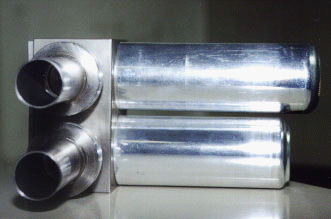 While passing through the can, some of the beam will interact with deuterium, helium 3, or hydrogen gas depending on experiment criteria. Less than one percent of the passing electrons break away from the beam; scattering outward through the can's sides. The target system is enclosed in a large circular vacuum scattering chamber. The arrangement will provide insulation as well as prevent "multi-scattering effect." Researchers will use a spectrometer to measure the energy and angle of scattered particles. The majority of the beam continues through the target cylinder and is directed to the beam dump where it is stopped.
While passing through the can, some of the beam will interact with deuterium, helium 3, or hydrogen gas depending on experiment criteria. Less than one percent of the passing electrons break away from the beam; scattering outward through the can's sides. The target system is enclosed in a large circular vacuum scattering chamber. The arrangement will provide insulation as well as prevent "multi-scattering effect." Researchers will use a spectrometer to measure the energy and angle of scattered particles. The majority of the beam continues through the target cylinder and is directed to the beam dump where it is stopped.
Most target designs utilize just one target apparatus, and the experimenter must go through the arduous and time consuming process of emptying one gas out of the cylinder and replacing it with another when they want to conduct experiments using a different gas. Bart Terburg, a graduate student working on the project, explained that the Hall C design addresses an important issue of efficiency. Because the Hall C target design consists of three separate targets, gases will continuously circulate through separate systems so that three target types will always be available for testing. In such a design, experiment changes will consist of a flip of a switch, thus saving time and money.
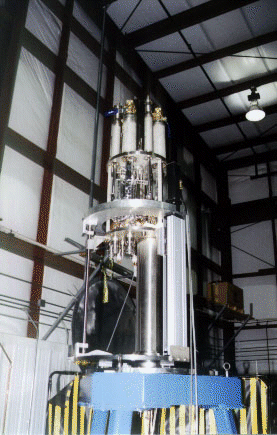 The vertical target assembly consists of a stand where the three target cylinders and their related mechanisms are mounted. To activate a particular target, a scientist will push a switch to lower a target from the stand into the vacuum chamber. However, while the design sought to allow experiments to be conducted with more efficiency, it also had to satisfy design size restrictions. Since the space was unavailable to simply stack one target onto another they employed various innovations in order to produce a target of compact design.The assembly can rotate 90 degrees to allow additional solid targets to be placed in the beam line. Another space saving design innovation was the placement and design of the cryogenic system.
The vertical target assembly consists of a stand where the three target cylinders and their related mechanisms are mounted. To activate a particular target, a scientist will push a switch to lower a target from the stand into the vacuum chamber. However, while the design sought to allow experiments to be conducted with more efficiency, it also had to satisfy design size restrictions. Since the space was unavailable to simply stack one target onto another they employed various innovations in order to produce a target of compact design.The assembly can rotate 90 degrees to allow additional solid targets to be placed in the beam line. Another space saving design innovation was the placement and design of the cryogenic system.
The target is cryogenic, meaning it utilizes a cooling system to keep the target gases in a liquefied state. Usually pumps transfer helium coolant through a series of tubes. The target gases are cooled as a fan circulates target gases over and around tubes filled with helium. Usually, such a fan is built externally of the target. To conserve space, the Hall C design uses small fans which are buried within the heat exchanger to cool target gases.
Team members roundly expressed that the complexity of the project encouraged innovation. "It took some time to develop, but with a project like this you go down one road and find a roadblock. So then you turn around and head down another road to get it [the job] done. It was a big job, but everyone in the group has worked on it and invested a lot in it," says designer Jim Takacs.
Terburg stressed that the project has provided countless problem solving experiences, but he most appreciates the teamwork. "The best thing is the interaction of the designers, physicists, engineers and technical staff. They brought everything together," says Terburg.
After an eight month accelerated development period, the target is to be installed and operational in September.The installation will signify the transition from construction to experimentation in Hall C.
Will Conners, Director's Office Intern
Robin Cowherd: Striking a balance
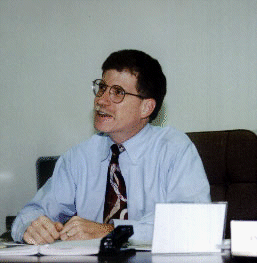 Workforce restructuring, race relations, job satisfaction, conflict resolution, professional development. The issues are real, and so are the people that are affected by them. For a Human Resources Director, such daunting challenges are typical of the issues faced when designing and guiding human resources departments. Robin Cowherd, CEBAF's new Director of Human Resources, has built a career on finding unique solutions that equitably benefit both employee and employer. "Human Resource departments must put employees first...we must be responsive to the customers [employees] we serve. My greatest goal will always be to balance the needs of the organization with the needs of the individual,"says Cowherd.
Workforce restructuring, race relations, job satisfaction, conflict resolution, professional development. The issues are real, and so are the people that are affected by them. For a Human Resources Director, such daunting challenges are typical of the issues faced when designing and guiding human resources departments. Robin Cowherd, CEBAF's new Director of Human Resources, has built a career on finding unique solutions that equitably benefit both employee and employer. "Human Resource departments must put employees first...we must be responsive to the customers [employees] we serve. My greatest goal will always be to balance the needs of the organization with the needs of the individual,"says Cowherd.
Cowherd recently joined CEBAF after 13 years of service in the Department of Human Resources at Old Dominion University, where he last held the position of Director. Cowherd characterized his experience at the University as a joy and a challenge. "Initially, the department was functioning in a benefit maintenance mode. Over time, we developed the department with a focus on customer service," says Cowherd. Utilizing a number of initiatives, Cowherd focused on improving the delivery of human resource services, employee feedback, and workplace harmony.
One initiative Cowherd cites as a memorable achievement was the implementation of an employee attitude survey. "We wanted to get a sense of what we were not doing right. From the results, we were able to organize programs that addressed the issues that were raised in the survey," he said. Due to survey findings, Cowherd led efforts to develop diversity training programs to improve race relations. The College and University Personnel Association recognized the program with an award of achievement.
Cowherd's former colleagues at ODU are saddened by Cowherd's departure but also pleased that he will be able to apply his talents in an environment such as CEBAF's. "I worked with Robin for ten years. He is not only a great person but a super human resources professional," says ODU's Acting Director of Human Resources Glenda Humphreys. "Robin is someone that is recognized around the state as being on the cutting edge of human resources," she adds.
An emphasis on the concepts of Total Quality Management and customer service are clearly rooted in Cowherd's training in public administration. Cowherd received both bachelor's and master's degrees in Public Administration from West Virginia University. Upon graduating, Cowherd was eager to begin working and accepted a position with a hospital to formulate and maintain personnel services. This initial position lead to a succession of human resource positions with ever increasing responsibilities.
Cowherd's current focus is familiarizing himself with the human resource needs and policies of CEBAF. "I'm still reviewing everything. I don't want to make changes too quickly. All too often when someone comes into an organization they have the walls painted just to feel like they have changed something. But in reality the change may not add value to the organization's mission," says Cowherd. He adds that in an organization, the question that should always be asked when reflecting on decisions is "Was it the right thing to do?"
Conflict resolution is also of great importance to Cowherd. He notes that many different people have varying ways of approaching their job and organizational missions. "Sometimes differences lead to conflicts, and it then becomes a Human Resource task to help employees and supervisors find a solution to the conflict. We must all realize that an organization engages the services of human beings. We can strive to accommodate an individual [within the organization's mission] to empower that person to do their very best," says Cowherd. His philosophy is driven by a constant awareness and reevaluation of both individual and organizational contributions to fulfilling a mission.
"Everyone can succeed in adding value to the final product or service of an organization. Don't think about what you can't influence. Think about your own sphere of influence. We need to ask ourselves how can we deliver a better product or service to our immediate customers who may be our co-workers, or our supervisors," says Cowherd.
Will Conners, Director's Office Intern
12th annual Users Group Meeting at CEBAF
Meeting focuses on accomplishments, future
The 12th Annual CEBAF Users Group meeting, held June 22 and 23, was convened to discuss accomplishments made during the past year and focus on the near-term physics program. Doug Beck, Users Group Chair, opened the meeting with brief comments on CEBAF's transition into its "life as a scientific facility," then turned the meeting over to CEBAF's Director, Hermann Grunder. Grunder updated the Users on CEBAF's progress and invited them to share in the signing of the new contract between SURA and DOE.
Commenting on the performance based contract, Beck said that it offers five years of strength and stability to Users, and that its first measurement is the scientific output of the laboratory.
Roy Whitney, CEBAF User Liaison Office, announced the next PAC and the Call for Proposals. The Call for Proposals will be issued in August, with an estimated due date of November 7; PAC 10 will convene in January of 1996.
Experiment scheduling will be conducted every 6 to 12 months, and in August the Hall C Review Panel will meet to review preparation needs for several experiments.
User space concerns were addressed with the announcement of the SURA Residence Facility expansion-16 more rooms by July 1996-and additional office space in the Counting House, Trailer City, and the new city-built "ARC" building, which will be available for occupancy in approximately 24 months. Additional discussion centered on the services available through the User Liaison Office, data system procurements, and the Physics Computing Advisory Committee.
Beck announced new members of the Users Group Board of Directors: Chair Elect, Betsy Beise, University of Maryland; new members Reinhard Schumacher, Carnegie-Mellon, and Larry Weinstein, Old Dominion University.
The remainder of the meeting consisted of presentations on experiments by the "younger" members of the User community, ending with a tour of CEBAF.
Karen Hokansson, User Liaison Administrator
Parnering to Win
Staff Contributes expertise to help build school's electric car
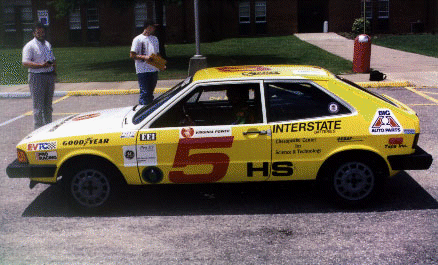
When the Chesapeake Center of Science and Technology accepted a challenge to build an electrically powered vehicle, or EV, Tom Spencer, an engineering instructor at the school, decided to use contacts that he made while working at CEBAF to get help. Spencer was a participant in CEBAF's Summer Institute for Teacher Enhancement program, or SITE, two years ago. While here, Spencer worked with Brian Kross, CEBAF Associate Coordinator for the Physics Department, on the Hall A gas system. After the summer program ended, the two men managed to keep in touch which proved to be a valuable asset for Spencer and his school. Each year the Virginia Electric Power Company (VEPCO), in an effort to promote the further development of energy-saving technology, coordinates a regional competition in which schools from Virginia and North Carolina participate in the EV Grand Prix. The program challenges the schools to design and construct their own electric vehicle. Upon completion, the schools contend with each other at the Richmond International Speedway. The winner then competes at the national level.
The school had four short months to build their own EV before the May 6 competition.
The faculty and students wasted no time getting started on turning a donated Volkswagen Scirrocco, from a standard fuel powered car to a high-tech electrically powered vehicle. Spencer immediately called Kross hoping to get a little technical advice. However, what he got was more than he expected. Kross was able to connect Spencer into a network of advice and support.
CEBAF sponsored the effort by providing technical help and services. Members of the Machine Shop helped design and fabricate the motor adapter plate which allowed the car's original transaxle to be coupled to the electric motor.
Anthony Day, Hall B drift chamber technician and another of Spencer's friends from his SITE days, also lended a helping hand. Day was able to assist, because of his experience building his own EV. He helped locate parts and materials used in the construction of the vehicle.
"The staff at CEBAF was a big help, however, it was really the faculty and students at the school who deserve all of the credit," says Spencer. In fact, the school tried to utilize all of its resources with students and instructors from many classes pitching in.
All of their hard work, much of which was done on nights and weekends, really paid off in the end. The car came in first during the acceleration event and placed fifth in the overall competition. It was also the only car to successfully pass the event's technical safety inspection with flying colors, even though one of the inspectors tried to fail the car because it had no catalytic converter, ironic since a catalytic converter is useless on an electric vehicle since the car is designed to release virtually no exhaust gasses.
Kross, who was given the opportunity to drive the car, was impressed with the quality of the student's work. "It was amazing that these students were able to do such a professional job with the small amount of time and experience that they had," says Kross. "The car was so clean, and it handled like a regular car. They did a beautiful job."
David Ellis, Director's Office Intern
Smooth Delivery
A journey of a thousand miles begins with one step. This age old saying fits many of the complicated projects that are undertaken at CEBAF. One such example is the recent movement of a huge metal box beam, from the storage lot behind the end stations, into Hall A. To make it down into the hall, the 55 ton 80-foot-long structure had to slide down a 15-by-15-foot tunnel 380-feet long with a 10 degree slope. This photo essay documents the week-long undertaking.
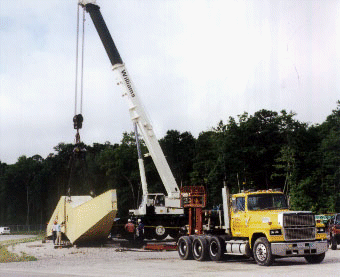
1. A 110-ton Krupp Crane prepares to hoist the box beam on to a two piece trailer called a bolster which will be used to transport the box beam down CEBAF Boulevard.
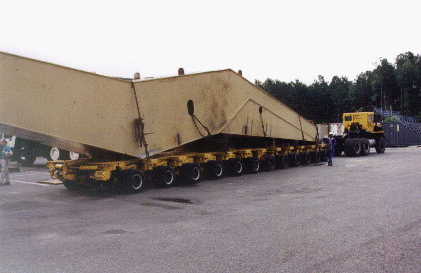
2. A Nichols trailer, made up of 12 hydraulically controlled, adjustable segments, aided in allowing the box beam to be transported more easily around corners and curves on the road.
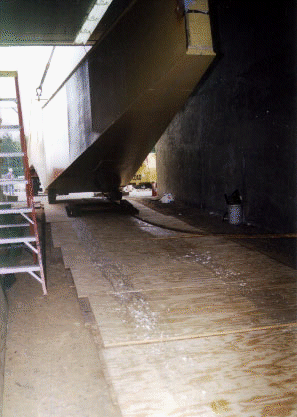
3. Two layers of plywood are laid down on the floor of the Hall A truck ramp to create a smoother surface for the movement. The first layer is rough to keep the wood from slipping and the smooth second layer is staggered on top to keep the sleds from getting stuck in cracks. Liquid Ivory and Ivory soap flakes are laid out into two tracks to help decrease friction. A tow chain runs from underneath the front of the box beam to the back of the "pull" truck.
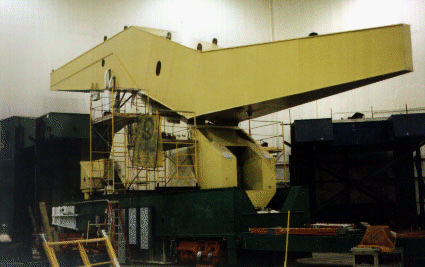 4. The box beam is resting in its final place atop the electron arm dipole. The box beam will act as an optical bench for the magnetic elements of the spectrometer. These elements consist of three quadropole magnets and one dipole magnet.
4. The box beam is resting in its final place atop the electron arm dipole. The box beam will act as an optical bench for the magnetic elements of the spectrometer. These elements consist of three quadropole magnets and one dipole magnet.
Photos and text by David Ellis, Director's Office Intern. Technical assistance by Bill Schneider, Joyce Miller, John LeRose, and all of Physics.
Continuing the Quality Journey
After a sabbatical, CEBAF's Quality Advisory Council has resumed its activities with several new members. Reza Kazimi, Sandy Philpott, Gordon Smith, Brian Murphy, Elton Smith, and Dick Lusk join veteran QAC members Steve Hickson, Betty Beeler, Deborah Dowd, Mel Washington, Cathy Williams, Skip Callis and Peter Kneisel to advise the Director's Council in matters related to CEBAF's Quality Journey. The Council's first meeting took place with Director Hermann Grunder providing a framework for the work the QAC will undertake in the coming year, and setting the stage for what he hopes will be a spirit of collaboration between the QAC and the Quality Leadership Council (Director's Council). The QAC has elected Steve Hickson as its Chairperson with Brian Murphy as Co-Chairperson.
The QAC was implemented to provide input and advice in developing and following a roadmap for the Quality Journey. The first Quality Council generated a number of ideas that have since been implemented such as the in-house open house, and led to some cross-cutting teams such as the employee suggestion team and the performance appraisal team.
All Quality Council members are eager and anxious to have the input of the laboratory in how we can best improve quality here at CEBAF, please feel free to contact any one of them with your concerns or ideas, since they are there to represent you. Together, we can all make progress toward making CEBAF the best it can be!h
Deborah Dowd, Chief-of-Staff, Director's Office
Briefly...
New COUPR Internship
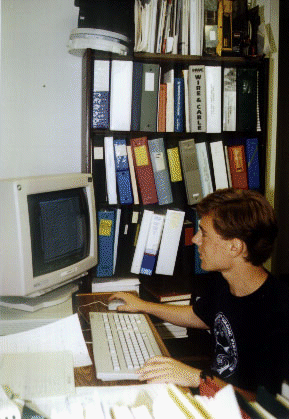 There's a new physics internship program at CEBAF. The CEBAF Outstanding Undergraduate Physics Researchship, or COUPR, program aims to recognize and recruit the nation's most promising undergraduate physicists and immerse them in the physics of CEBAF by providing them the opportunity to interact with CEBAF's staff and visiting scientists through working with them in a learning environment.
There's a new physics internship program at CEBAF. The CEBAF Outstanding Undergraduate Physics Researchship, or COUPR, program aims to recognize and recruit the nation's most promising undergraduate physicists and immerse them in the physics of CEBAF by providing them the opportunity to interact with CEBAF's staff and visiting scientists through working with them in a learning environment.
The experience is expected to encourage the students to pursue advanced degrees in CEBAF-related disciplines. Students were selected based on academic excellence, interest in physics research at CEBAF, recommendations, etc. The summer-long program (May-August) is being tested on five participants from three universities. They are: Otis Pefifer and Dwight Eley, North Carolina Central University; David Turissini and Troels Petersen, Indiana University; and Ricardo Walker, Virginia Union.
Look for program announcements to go out in January 1996. For more information, contact Carl Bennett, University Relations at 249-4867.
Clubs by e-mail
Mail groups have been formed for activities and clubs at CEBAF. These groups are desgined to bring people with similar interests and diverse backgrounds together. Groups include golf, tennis, volleyball, soccer, fishing, biking, running, gardening, roller bladers, motor sport fans, roller blading and racquet ball.
The mail groups are rec_golf, rec_tnns, rec_vlly, rec_sccr, rec_fish, rec_bike,rec_run,rec_grdn, rec_bldz, rec_rcqt, and rec_race. To subscribe to a group,send mail to mailserv@jlab.org with a single line message of subscribed group name. For example:
mail>send
to: >mailserv@jlab.org
subj: >rec_race
>Subscribe rec_race
exit
Free tickets for Tides Baseball
Come join the Employee Recreation Committee for FREE Tidewater Tides Baseball at its best! At 7:15 p.m., August 11, the Tides will face off against their rivals the Richmond Braves at Harbor Park in Norfolk.
Recieve free tickets, with a maximum of six per person. Tickets will be distributed on a first come, first served basis at Staff Services, so don't miss out! For more information, call Deborah Hyman at ext. 4852. See you at the ball game!
Family fun
It's CEBAF Day at Kings Dominion and everyone's invited. Don't miss a day of fun, sun and thrills on August 19 at the discounted price of $17.95 per person. Regular price is 27.95 for adults and $19.95 for children. Kings Dominion boasts a large waterpark, Nickelodeon theme park, and more for children of all ages. Play all day, then watch the fireworks beginning at 10 p.m. Reserve your tickets at Staff Services. Deadline for sign-up: August 5. Transportation is not included. Pack a cooler, put on your CEBAF T-shirt, and join the fun! For more information, contact Eric Woodworth at ext. 7217.
Class Act
First Class Contracting Wins SURA/CEBAF Small Business Award
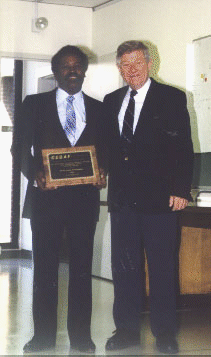 Butch Hudgins' 24 years in construction are evidenced by the hard calluses and firm grip of his hands. One learns quickly though, that it is Hudgins' prowess as a businessman that has earned him the respect of many at CEBAF. His recent achievement of CEBAF's Small Disadvantaged Business Award for the second consecutive year confirms that Hudgins' continues to distinguish his company, First Class Contracting, through a commitment to quality and customer service. Hudgins started his career as a construction laborer. Working his way up the ladder, Hudgins ultimately earned the position of superintendent. Like many though, the economic turmoil of the late 80's prompted Hudgins to make a decision that would change his personal and financial future.
Butch Hudgins' 24 years in construction are evidenced by the hard calluses and firm grip of his hands. One learns quickly though, that it is Hudgins' prowess as a businessman that has earned him the respect of many at CEBAF. His recent achievement of CEBAF's Small Disadvantaged Business Award for the second consecutive year confirms that Hudgins' continues to distinguish his company, First Class Contracting, through a commitment to quality and customer service. Hudgins started his career as a construction laborer. Working his way up the ladder, Hudgins ultimately earned the position of superintendent. Like many though, the economic turmoil of the late 80's prompted Hudgins to make a decision that would change his personal and financial future.
Facing industry-wide downsizing that would have forced him to accept a new job that entailed frequent relocations, Hudgins decided to go into business himself. "Companies just aren't as loyal as they used to be, and I didn't want my family to have to move every two years," says Hudgins. Using his retirement savings, knowledge, and skill, Hudgins founded First Class Contracting in 1990. The company employs five full-time employees.
Knowledge of government contracting practices gained as a former superintendent, gave Hudgins the ability to bid and win federal contracts. Hudgins admits that the first year was particularly difficult as he set out as an entrepreneur. He says the cost of doing business can almost be overwhelming. The types of liability insurance which the federal government requires of contractors can be a serious obstacle. However, Hudgins credits the Small Business program at CEBAF with helping him market his business and better understanding federal contracting processes.
First Class has completed over 100 small projects at CEBAF over the past year. Hudgins says his toughest job has been filling stress cracks in the concrete of the accelerator. Cracks must be drilled and prepped before Hudgins injects "hydrofoam" into the openings which expands as it comes into contact with moisture. The job is particularly problematic when working in the accelerator tunnel, as workers must work around the accelerator itself. Hudgins says that 99 percent of the cracks are under control.
At the presentation of the Small Disadvantaged Business Award, Dean Helms described Hudgins willingness to go the extra mile. "It did not matter if Butch had to work long days and nights. Butch would do what it took to get the job done under budget and on time," said Helms.
Hermann Grunder stressed that the award is a recognition of the importance of small businesses in the economy. "Small businesses are the backbone of the economy. You [Butch Hudgins] fill a critical part in our economy by operating businesses with low overhead and the ability to provide excellent services with a quick turnaround," said Grunder.
Hudgins expressed satisfaction at receiving the award and contracting for CEBAF. "It [the award] will enhance my business in not only the government sector, but in the commercial sector as well. There are a lot of great people at CEBAF...they have always been very professional and courteous," he said.
Will Conners, Director's Office Intern
HUGS Celebrates 10-Year Anniversary
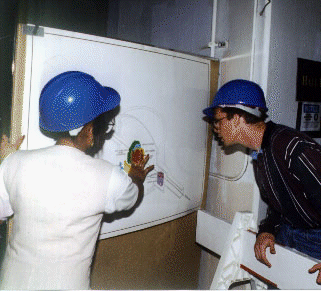 Ten years, a decade, a long time. That's how long the Hampton University Graduate Studies, or HUGS program has been around at CEBAF. The program was celebrated in early June with a special series of lectures called, "Advanced HUGging." Special guests and past participants were invited to speak at the lectures. HUGS is a summer program geared to second- and third-year physics graduate students who have finished or almost finished their coursework. The program gives them the opportunity to learn about nuclear physics in a relaxed atmosphere while interacting with CEBAF staff members. The students, who are selected on a competitive basis by a local admissions committee, also receive one transferable credit hour.
Ten years, a decade, a long time. That's how long the Hampton University Graduate Studies, or HUGS program has been around at CEBAF. The program was celebrated in early June with a special series of lectures called, "Advanced HUGging." Special guests and past participants were invited to speak at the lectures. HUGS is a summer program geared to second- and third-year physics graduate students who have finished or almost finished their coursework. The program gives them the opportunity to learn about nuclear physics in a relaxed atmosphere while interacting with CEBAF staff members. The students, who are selected on a competitive basis by a local admissions committee, also receive one transferable credit hour.
Thomas Eden, the current HUGS Coordinator, participated in the 1992 program. He says, "the goal of the program is to provide CEBAF an avenue to educate students on current topics in nuclear physics and how different types of physics are investigated here at the facility." Eden says the program has been a success, attesting to the facts that the program has gained worldwide attention, the diversity of the kinds of students who apply, and the rate of past participants who go on to receive their Ph.D.'s.
Curt Foltz is one past participant who went on to obtain his doctorate. In fact, Foltz attended the very first HUGS Program in 1985. Foltz, who gave a lecture during the Advanced HUGging seminar entitled, "Diversifying to Enhance Undergraduate's Education," now teaches physics at various four-year colleges.
"I try to give students the impression that, while some theory or device is hard to work with, the struggle is often worth it," says Foltz. "The HUGS Program was the first time I had seen an extended meeting of physicists trying to accomplish something. "
As with most programs, HUGS has a few difficulties that need to be worked out. One of these problems, says Eden, is the lack of women participating in the program. He adds, however, the trend is going up, with four women attending this year. Foltz would also like to see some changes, including opening the program to all physics students, not just the second and third year graduates. By doing so, Foltz believes that it will give students more time to experience the working environment of CEBAF and enable them to take advantage of the expertise that surrounds them here.
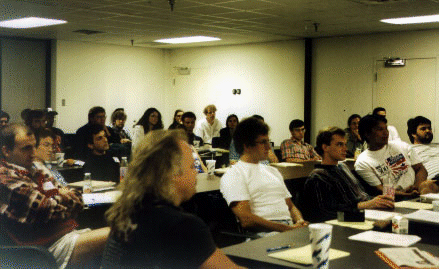 According to HUGS Program Director Warren Buck, the program has trained approximately 175 graduate students. Several of these students, such as Christopher Newport University graduate Zhujun Li and Hampton University graduates Robert Williams, Cynthia Keppel, and Ioana Niculescu, hold positions at CEBAF.
According to HUGS Program Director Warren Buck, the program has trained approximately 175 graduate students. Several of these students, such as Christopher Newport University graduate Zhujun Li and Hampton University graduates Robert Williams, Cynthia Keppel, and Ioana Niculescu, hold positions at CEBAF.
Li and Williams have joint positions which involves splitting time between teaching at their schools and working at CEBAF. Keppel will soon accept a joint position. Niculescu has become a facility user in the Physics Department.
Did you know?
CEBAF is the world's most powerful microscope for studying the nucleus of the atom.
If CEBAF weren't superconducting, it would require three times as much power to operate and performance would be greatly reduced.
The tunnel is built 25 feet below the earth's surface on the "Yorktown Formation"-an old sea bed. k Approximately 25,000 cubic yards of concrete were used to build the tunnel-the equivalent of 12-miles of concrete trucks lined up end-to-end.
CEBAF's accelerator tunnel has more than 2,200 magnets in 58 varieties. They range in size from a few inches to two yards and weigh as much as five tons.
The accelerator is controlled and monitored by computers in the Machine Control Center that track, manage, and respond to more than 100,000 simultaneous signals and 25,000 hardware control points.
CEBAF's electron beam travels around the 7/8 mile tunnel five times in 24 millionths of a second. At that speed, the electron beam could circle the earth 7 1/2 times in one second.
The mass of an object increases as its speed increases. At nearly the speed of light, the electron in CEBAF's beam increase in mass 7,830 times.
These CEBAF tidbits were taken from a fact sheet available in the Director's Office

